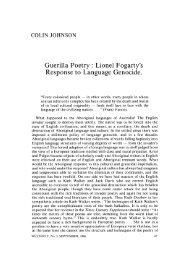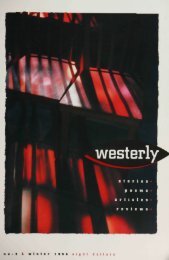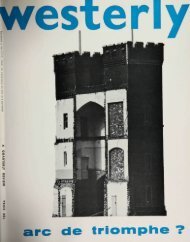the literary life of Bloomsbury. London was full of Australian artists and writers:some, such as the artist Will Dyson, and Esson's half brother Frank Brown, havingcome back wounded from the trenches. After the war others, including Vance Palmerand also a young playwright, Sydney Tomholt, were in London waiting to berepatriated. Also there, working as a journalist and doing war work on the homefront, was William Moore, at one of whose 'Drama Nights', back in Melbourne in1910, Esson's first play, The Woman Tamer, had been produced. Moore gatheredthe little band of expatriates together and tried to organize a programme of oneactAustralian plays for production. And so it was that, in a little flat in Bloomsbury,with the prospect of a London production, Esson wrote his first successful Australianfolk bush drama, The Drovers. It was to exert an influence for 30 years, and is stillregarded as one of the best one-act plays written by an Australian.The plays Moore gathered were never produced but Esson did find a Londonpublisher for a volume of his one-acters, a volume which included Dead Timberand The Drovers, and he was delighted and flattered when Yeats wrote to himpraising the work and asking him to come down for a stay at the Yeats householdin Oxford. So began the second great pilgrimage. Esson later looked back on theexperience and wrote, conscious perhaps of the ironies of his position:I had a little difficulty in connecting the Irish poet with Oxford, but it was quiet, he said,and he was near Bodleian, a famous and comfortable library. Every summer he goes toIreland, to a romantic old castle, a beautiful place, that has been raided during his absenceby the Black-and-Tans. I was proud to make my pilgrimage to Oxford, and the poet'sstudy, with its fine books, the great brass candlesticks, the pictures by his father and brother,and the Blake drawings, will always seem to me the most eloquent place in the world. 14Yeats met Esson at the station and took him home where they had 'a simple meal,with sherry in his favourite Jacobean decanter.' There were no long late walks bynow. After dinner they went upstairs to Yeats' sitting room and sat around the glowingIrish peat fire, with the soft light of the candles in the great brass candlesticks. Esson,in Australia, had a reputation for being one of his circle's greatest conversationalists,but in the presence of his master he was mainly silent. He wrote later that Yeats'talked till after midnight, touching on and illuminating all sorts of themes',15including early Egyptian art, Blake, Shelley, Browning, Balzac, the Irish literarymovement, Shakespeare, Henry James, Tolstoy and the Saints, Japan, and, last butnot least - well, perhaps least - what he called the 'distinctive nationality ofAustralia.'16 Esson must have said enough to convey to Yeats some of the self-doubtwith which he was troubled, for the poet reassured him by pointing out that 'Youhave been in Australia longer than the Icelanders have been in Iceland when theycreated their great sagas.'17They also talked about Ben Jonson and when Yeats expressed an interest in aprivate production of Volphone by the Phoenix Society in London, Esson, in a stateof high apostate excitement, was able to invite his master to it, for he was a member.Years earlier, in late 1904, Esson had arrived at the Abbey Theatre and had takena cheap seat, out of humility rather than poverty. From on high he had watchedYeats prowling the stalls and had not realized until afterwards that the poet hadbeen looking for him. By 1920 things had changed. A week after the meeting inOxford Yeats came up to London:I escorted him to his seat in the Lyric Theatre, Hammersmith. He caused a sensation,dressed in a suit of fawn velvet corduroy, with a big silk scarf tied in a bow, pince-nezattached to a broad black ribbon, and the mass of iron-grey hair swept back from hisgreat forehead. During the interval he met Bernard Shaw. "This is not a play for you,Shaw," he said. That was all the conversation we had. 1838WESTERLY, No.2, JUNE, 1989
Considering the success of Esson's only Shavian comedy, nearly a decade earlier,it was perhaps a pity that he did not get to speak more with Shaw. But by thattime he had turned his back on all that.Mter the performance Yeats left for Oxford with Lennox Robinson to discussplans for his poetic Tragic Theatre for Ireland, and Esson never saw him again. Inhis obituary tribute he wrote,[Yeats] was a fascinating personality, a brilliant wit and talker, when in the mood, though,like Shelley, dumb and helpless amid ordinary prosaic conversation. He was the HighPriest of Irish Letters, and not only produced great drama and poetry himself, but inspiredothers - Synge, Colum, Lady Gregory and even George Moore - to some of their highestefforts. He was that rare phenomenon, a really vital and creative force. 19He does not mention it but Yeats had inspired Esson also, perhaps even to hishighest efforts, but as Esson was to discover for himself, after his return to Australiain the spring of 1921, those efforts were either not enough or were misdirected.Perhaps the very enthusiasm with which Esson wrote of the poet's study, with itsBlake drawings and its peat fire and its exalted conversation about the greatest ofWestern art, should have warned Esson that his struggles to establish a version ofthe Abbey in Australia, using themes from the Australian bush, would bedisappointing.Mter all this Esson returned to Australia full of high hopes, and embarked onhis most productive period as a playwright. With Palmer and another friend andaspiring writer, Stewart Macky, he founded the Pioneer Players, and between 1922and 1926 they produced a number of Australian plays which helped to establishthe tone of the bush drama which dominated Australian playwriting throughout the30s and 40s. Esson at last began to write full-length plays in the style of those 'studies',which he had published in his first volume in 1911: studies for the kind of long playswhich he really wanted to write. In spite of its eventual failure the Pioneer Playershas since been seen as living up to its name, playing a crucial role in the earlydevelopment of modern Australian drama.The reasons for the eventual failure of the company are various. There was noMiss Horniman to support it financially during its early years. Australian audienceswere, as Esson ought to have expected given his early views about their philistinism,apathetic, or, if they did come, suspicious and distant. What taste the popularaudiences had for Australian material was well-satisified by an active and successfulAustralian film industry, an industry which lacked the self-consciousness about highinternational artistic standards which Esson and his colleagues tried to apply.The most important reason, however, was probably simply that Yeats' leadershiphad been so inspiring, and his practical advice so specific, that it left little roomfor Esson to respond creatively to the real questions which were facing him inAustralia in the 20s. What Esson was really interested in were issues of individualfreedom in a conformist society, the role of creativity and imagination in leadinga fulfilling life, and the search, on the personal and community levels, for anadventurous vitality of spirit with which to face the harsh realities of the world,realities which in Esson's world were becoming harsher with each passing year ashis writing declined in the late 20s and the 30s, with the Depression and anotherwar. He wrote about these issues often in his journalism, but he came to considerthis as mere hack work. He seldom wrote about them in the work in which he investedthe most faith and energy - his plays. In those, ever respectful of his mentors, hevainly strove to find a popular folk idiom rich with folk traditions which simplydid not exist in Australia. Even in the country of his new inspiration - Ireland- Synge's Aran islands, and Yeats' Cuchulan, Deirdre and Conchubar, came toseem a little remote from reality in the years of the Anglo-Irish War and after. Therewas no hope of finding an equivalent in Australia.WESTERLY, No.2, JUNE, 1989 39
- Page 3 and 4: CONTENTSWESTERLYVOLUME 34, No.2, JU
- Page 5: WESTERLYa quarterly reviewISSN 0043
- Page 8 and 9: JAN KEMPTo My Father, M.H.K.My fath
- Page 10 and 11: JAN KEMPThe GypsySuddenly before yo
- Page 12 and 13: WONG PHUI NAMA Death in the WardThe
- Page 14 and 15: WONG PHUI NAMCousinI had to call to
- Page 16 and 17: WONG PHUI NAMObitIt is as thin smok
- Page 18 and 19: So thus I lie here fearful of movem
- Page 20 and 21: VIRGINIA BERNARDA ValedictionWhen N
- Page 22 and 23: "Yeah, yeah," I call, returning the
- Page 24 and 25: she flops for a bit, slurps her tea
- Page 26 and 27: well her students did, she was neve
- Page 28 and 29: English or Indian, that they had th
- Page 30 and 31: ANDREW TAYLORSpringSpring is a dive
- Page 32 and 33: CAROL SElTZERAiming for the MouthTr
- Page 34 and 35: GRAEME WILSONA Selection of Japanes
- Page 36 and 37: a highly ambivalent attitude to his
- Page 38 and 39: Esson attended some rehearsals of T
- Page 42 and 43: Without Yeats Esson would quite lik
- Page 44 and 45: "What theatre do you have in Austra
- Page 46 and 47: In the back room Esson could feel t
- Page 48 and 49: "When we started our little theatre
- Page 50 and 51: a screen against a wall. A theatre
- Page 52 and 53: VINCENT O'SULLIVANSinging Mastery:
- Page 54 and 55: flighty relation in most statements
- Page 56 and 57: living and the dead; that places hi
- Page 58 and 59: quite diverse traditions towards th
- Page 60 and 61: WARRICK WYNNEThe Wetlands (for Liam
- Page 62 and 63: JAN OWENSmileOur mother aimed the b
- Page 64 and 65: RICHARD KELLY TIPPINGOlympic Airway
- Page 66 and 67: DAVID REITERBear by the Jasper Road
- Page 68 and 69: (At twenty eight you did not bother
- Page 70 and 71: left, would have risen and walked o
- Page 72 and 73: He had hair like mine used to be, t
- Page 74 and 75: OLIVE PELLThe QuestionTell me how t
- Page 76 and 77: BRIAN MOONANAT 515: MASS LECTURE Th
- Page 78 and 79: PETER KIRKPATRICKTear HereThe bay i
- Page 80 and 81: JOHN WINTERThe Bird ManIn wooded, p
- Page 82 and 83: KNUTE SKINNERAugust 15There's a lig
- Page 84 and 85: M.E. PATTI WALKERThe Hook"Aren't yo
- Page 86 and 87: QMNQMNQMNQMNapartheid man, this is
- Page 88 and 89: QMNQMNQMNeasy because you don't bel
- Page 90 and 91:
lands or which have been taken over
- Page 92 and 93:
GEOFF GOODFELLOWToo MuchDianne is 1
- Page 94 and 95:
SHANE McCAULEYSouth Fremantle, Summ
- Page 96 and 97:
JEAN KENTWaiting Out the DroughtWai
- Page 98 and 99:
STEPHEN MAGEEJesus Falls, South Aus
- Page 100 and 101:
SIMON BROWNBlue Hole, Santothe colo
- Page 102 and 103:
CONAL FITZPATRICKA Brown Dog, Off A
- Page 104 and 105:
PAUL HETHERINGTONOne RoomIn teeming
- Page 106 and 107:
society, or, in the terms of the my
- Page 108 and 109:
emphasised (I think) in the referen
- Page 110 and 111:
Summer Leaves". This continues the
- Page 112 and 113:
Deficiency Bill in Western Australi
- Page 114 and 115:
invocation of pastoral near the beg
- Page 116 and 117:
particularly dreaded). The final re
- Page 118 and 119:
VINCENT O'SULLIVAN - is one of New







